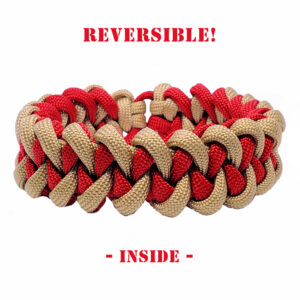A Brief History of Paracord & Paracord Types
For those of you that are new to the world of paracord, here is a quick overview of the history of paracord. Paracord (also known as parachute cord) was historically used by airborne units/divisions during World War II. Originally, parachute cords were used as the suspension lines for parachutes.
Today, paracord has a variety of other uses from rock climbing to make-shifting a tent, replacing shoelaces, creating a laundry line, etc. Two popular paracord types are 550 mil-spec paracord (military grade) and 550 commercial grade.
Mil-Spec Paracord
Mil-Spec paracord goes through military quality testing and must pass military standards such as temperature resistance and tensile strength. The outer casing is 100% braided nylon. Inside is typically a core made of seven to eleven 3-ply nylon cables (i.e., Type III versus Type IV). One of which is a tracer strand or ID marker which confirms its grade and quality.
Mil-Spec designation applies to 550lb (Type III) and 750lb (Type IV) strength cords. The diameter of Type III paracord is 5/32 in. (3.97mm). The diameter of Type IV is 3/16 in. (4.75mm).
Uses For Mil-Spec Paracord
Uses for mil-spec paracord range from parachute rigging and survival snares to shelter construction. This type of paracord is also great to include in a survival kit. The inner strands can also be pulled out and used for repairing shoes or even can be used as fishing lines.
Commercial Paracord
Commercial paracord is generally 100% nylon and is mostly made in America. The standard commercial 550 paracord rope has seven 2-ply twisted nylon cords inside. Type III commercial paracord contains seven 3-ply nylon cords. Hence the “III”. It is good to note, that there are variations in the quality of commercial paracord. So, be sure to purchase it from a reliable source like paracord-bracelets.com.
What Is Polyester Commercial Paracord?
There is also 100% polyester commercial paracord. Typically, this type of paracord is made overseas. The main reason for this is that polyester is cheaper than nylon. Also, there is not the same high-quality control as in the USA. Therefore, the products can be mass-produced and sold much cheaper. This results in a poor-quality product that is unreliable.
USA paracord manufacturers do commonly blend the two materials. This poly/nylon paracord is smoother and easier to handle than paracord purely made from polyester.

